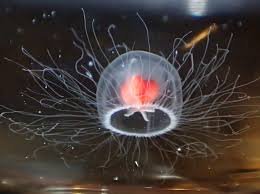Do you at any point wish you could hop move on schedule to when you were more youthful and start living once more? As life cruises us by, our bodies are intended to develop, age, and in the long run, kick the bucket. Be that as it may, not all species follow this cycle. Meet the everlasting jellyfish, Turritopsis dohrnii. Accomplishing what is just a hero dream for a considerable lot of us, age doesn't slaughter this minuscule, ringer molded wonders. Rather than following only one life cycle, the jellyfish can ride the cycle constantly, or until they wind up in the jaws of their fish hunters. Returning their bodies to their more youthful state, they get different opportunities in life.
Super-fueled doesn't really mean super-sized. At their biggest, they are still under five millimeters both in tallness and width. These jellyfish were first found in 1883 in the Mediterranean Sea, however just acquired their new moniker of the godlike jellyfish during the 1990s. While being concentrated in a lab, the jellyfish skirted the preparation stage and relapsed in development. It is imagined that the godlike jellyfish may utilize this ability in instances of crisis, for example, in the distressing circumstance of being contained in a little space.
- Egg
The jellyfish's life starts when the female's egg is treated by a male.
- Planula hatchling
At the point when the eggs have formed into planula hatchlings, they are delivered into the sea, starting a short free-swimming stage prior to choosing the ocean bottom.
- Fixed planula
Connected to the floor by means of one end, the planula stops to foster some more jellyfish-like highlights. It begins to develop appendages and a mouth.
- Polyp
When appended to the hard surface, it starts to change into a polyp. Some of the time staying in this stage for quite a long while, it is this tube-shaped, pre-jellyfish tail that grown-ups can later return to.
- Developed polyp
The polyp constantly divides its cells to create various clones of itself. While doing this its stature develops.
- Child jellyfish
Layers of the polyp split from the highest point of the chamber, turning out to be portable animals that can venture to every part of the ocean. These are child jellyfish called ephyrae.
- Adolescent
The youthful jellyfish slowly develops and develops. It starts to embrace the bigger, smooth chime of the grown-up jellyfish.
- Completely developed grown-up
With its total umbrella-formed chime and created limbs, the jellyfish have arrived at complete development. Now it has the choice to remember a large portion of the cycle by altering its phones.
